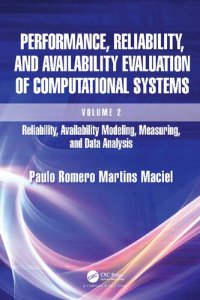
Ebook: Performance, Reliability, and Availability Evaluation of Computational Systems, Volume 2: Reliability, Availability Modeling
Author: Paulo Romero Martins Macie
- Genre: Computers // Organization and Data Processing
- Year: 2023
- Publisher: CRC Press
- Language: English
- pdf
This textbook intends to be a comprehensive and substantially self-contained two-volume book covering performance, reliability, and availability evaluation subjects. The volumes focus on computing systems, although the methods may also be applied to other systems. This text is helpful for computer performance professionals for supporting planning, design, configuring, and tuning the performance, reliability, and availability of computing systems. Such professionals may use these volumes to get acquainted with specific subjects by looking at the particular chapters.
Volume II is composed of the last two parts. Part III examines reliability and availability modeling by covering a set of fundamental notions, definitions, redundancy procedures, and modeling methods such as Reliability Block Diagrams (RBD) and Fault Trees (FT) with the respective evaluation methods, adopts Markov chains, Stochastic Petri nets and even hierarchical and heterogeneous modeling to represent more complex systems. Part IV discusses performance measurements and reliability data analysis. It first depicts some basic measuring mechanisms applied in computer systems, then discusses workload generation. After, we examine failure monitoring and fault injection, and finally, we discuss a set of techniques for reliability and maintainability data analysis.
Software failure is an out-of-specification result produced by the software system for the respective specified input value. This definition is consistent with the system failure definition. Hence, the reader might ask: why should we pay particular attention to software dependability issues? However, the reader should bear in mind that the scientific software communities involved in subjects have specific backgrounds, many of which are not rooted in system reliability. These communities have developed a specific vocabulary that does not necessarily match the common system dependability terminology. Software research communities have long pursued dependable software systems. Correction of codification problems and software testing begins with the very origin of software development itself. Since then, the term software bug has been broadly applied to refer to mistakes, failures, and faults in a software system, whereas debugging is referred to the methodical process of finding bugs.
Volume II is composed of the last two parts. Part III examines reliability and availability modeling by covering a set of fundamental notions, definitions, redundancy procedures, and modeling methods such as Reliability Block Diagrams (RBD) and Fault Trees (FT) with the respective evaluation methods, adopts Markov chains, Stochastic Petri nets and even hierarchical and heterogeneous modeling to represent more complex systems. Part IV discusses performance measurements and reliability data analysis. It first depicts some basic measuring mechanisms applied in computer systems, then discusses workload generation. After, we examine failure monitoring and fault injection, and finally, we discuss a set of techniques for reliability and maintainability data analysis.
Software failure is an out-of-specification result produced by the software system for the respective specified input value. This definition is consistent with the system failure definition. Hence, the reader might ask: why should we pay particular attention to software dependability issues? However, the reader should bear in mind that the scientific software communities involved in subjects have specific backgrounds, many of which are not rooted in system reliability. These communities have developed a specific vocabulary that does not necessarily match the common system dependability terminology. Software research communities have long pursued dependable software systems. Correction of codification problems and software testing begins with the very origin of software development itself. Since then, the term software bug has been broadly applied to refer to mistakes, failures, and faults in a software system, whereas debugging is referred to the methodical process of finding bugs.
Download the book Performance, Reliability, and Availability Evaluation of Computational Systems, Volume 2: Reliability, Availability Modeling for free or read online
Continue reading on any device:

Last viewed books
Related books
{related-news}
Comments (0)